Both the fieldmarshalls seem very cold about the idea, and seeing Terauchi is going to take the brunt of these offensives, it is correct of him, I suppose, not be quite so optimistic as his friend...
The Setting Sun - Gotterdammerung, Japan 1944.
- Thread starter unmerged(59906)
- Start date
-
We have updated our Community Code of Conduct. Please read through the new rules for the forum that are an integral part of Paradox Interactive’s User Agreement.
You are using an out of date browser. It may not display this or other websites correctly.
You should upgrade or use an alternative browser.
You should upgrade or use an alternative browser.
Reado - No leaking map this time as the attacks will be fairly fluid. Besides we all know that plans don't survive first contact with the enemy so the map would be ripped up shortly 
Kurt_Steiner - I think I could advance in almost any direction and be closer to Moscow right now
Avatar018, Inner Circle - I could lose you know if the Red Army work out my plans. They won't have much time to do so of course.
thatguy, Brad1 - Brad1 is correct I don't do large encirclements as the AI is hopeless against them, although it is slightly better with the 1.3a AI. The one at the beginning was handed to me on a plate and I really had no option as it was going to happen whether I was controlling things or not. Any future encirclements I do make a two year old could see coming as they take weeks to occur in this type of terrain
Maj. von Mauser - I am not chasing an Army. I am after an Army Group.
robou - The odds are not totally favourable right now which is why they are not totally convinced. You are correct when you say Terauchi is going to be in charge
Update to follow ...
Kurt_Steiner - I think I could advance in almost any direction and be closer to Moscow right now
Avatar018, Inner Circle - I could lose you know if the Red Army work out my plans. They won't have much time to do so of course.
thatguy, Brad1 - Brad1 is correct I don't do large encirclements as the AI is hopeless against them, although it is slightly better with the 1.3a AI. The one at the beginning was handed to me on a plate and I really had no option as it was going to happen whether I was controlling things or not. Any future encirclements I do make a two year old could see coming as they take weeks to occur in this type of terrain
Maj. von Mauser - I am not chasing an Army. I am after an Army Group.
robou - The odds are not totally favourable right now which is why they are not totally convinced. You are correct when you say Terauchi is going to be in charge
Update to follow ...
Operation Improbable
1
1
0100 May 1st 1947.
BB Division 1 Flagship. IJN Musashi, Gulf of Mannar.
Admiral Ozawa had been having a quiet time of late as the Allied fleets stayed away from any confrontation with the Imperial Japanese Navy. This allowed him to re-think some of his strategic positioning which led to a minor flurry of activity throughout the Pacific.
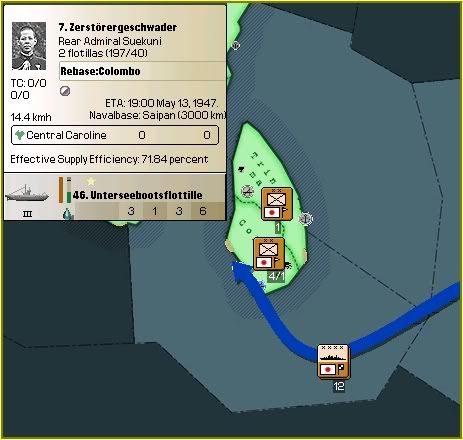
All Japanese Submarine fleets that had been operating in the Pacific, mostly around the Carolines, were ordered to rebase to Colombo where they would be used to provide advanced warning of incoming enemy shipping. Ozawa did not wish to have his main Battlefleets surprised in any way. All of these fleets would remain in their current areas of operation around the Indian Ocean.
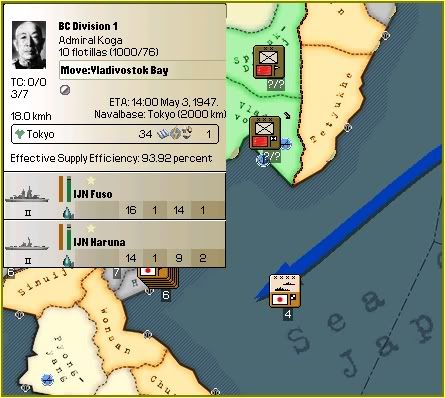
The only exception would be BC Division 1 which had been in Tokyo. Admiral Koga would add the Battleship IJN Fuso, which had completed its repairs, to his fleet to replace IJN Kongo which needed several months in dock. Koga sailed for Vladivostok Bay to support operations along the coast.

Japanese Transport ships would embark the troops used during Operation Tedious and move them to Vladivostok Bay. These forces had been landed on the northern Japanese island in Asahikawa where Mj. General Banzai joined them as he took command of the Imperial GHQ Infantry division. Command of his Marine division passed to General Imamura.
0100 May 1st 1947.
North China Army Headquarters. Lanzhou, China.
Higashikuni had not returned from his visit to Tokyo and was not scheduled to arrive until the following day, this left Field Marshall Sugiyama in temporary command of North China Army. He had already been briefed on what was required.
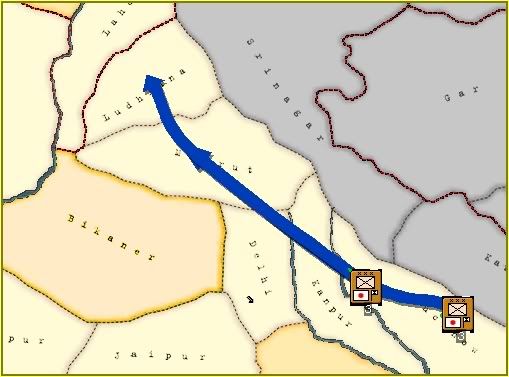
The forces that had withdrawn from the north Indian border began to move back to a more central position as it became clear that Japanese Tactical bombers would contain the Armoured spearhead of the Soviets.

Lt. General Takumi, protecting Bakhtaran province in Persia, received his marching orders. He was to head north and capture Tabriz. More than a month would be needed before Persia could be annexed by Japan.
0100 May 1st 1947.
Kwantung Army Headquarters. Mukden, Manchukuo.
Field Marshall Hata, second in command of the Kwantung Army, was also waiting for his commander to return from Tokyo. Terauchi had already passed on the more immediate orders that needed attention and Hata swiftly had the troops moving.
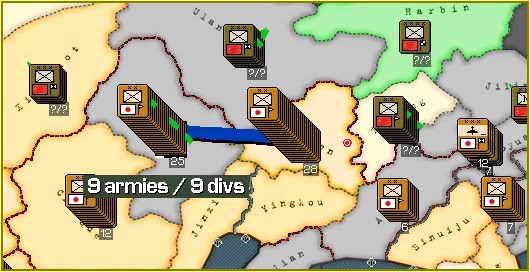
The nine Japanese divisions in Chifeng province began the short march to Mukden. This would leave sixteen Manchurian divisions defending Chifeng which was deemed adequate for the mountainous province given the current strategic situation. This would give a total strike force of thirty seven divisions in Mukden if they all remained there, which of course they wouldn't. Operation Improbable was aimed at one thing, the Soviet Army Group occupying Manchuria. The Kwantung Army had been tasked with destroying it completely.
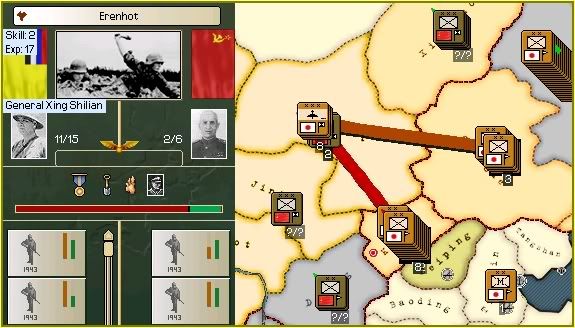
A minor diversionary attack was launched towards Erenhot at 0200 hours by forces from both Japanese Armies. General Xing Shilian commanded the eleven divisions that quickly overcame the weak defences of the province. No advance was ordered which was normal for this part of the line.
Terauchi had arrived back at his Headquarters before the appointed start time for Operation Improbable which gave him some time to consult various commanders and give out his orders. Additional supplies had arrived for the troops which would hopefully give them an edge over their adversaries.
At 2200 hours on May 1st two hundred and forty thousand Japanese troops launched a massive assault on the Soviet front line which would signal the beginning Tanigawa's plans.
Terauchi had arrived back at his Headquarters before the appointed start time for Operation Improbable which gave him some time to consult various commanders and give out his orders. Additional supplies had arrived for the troops which would hopefully give them an edge over their adversaries.
At 2200 hours on May 1st two hundred and forty thousand Japanese troops launched a massive assault on the Soviet front line which would signal the beginning Tanigawa's plans.
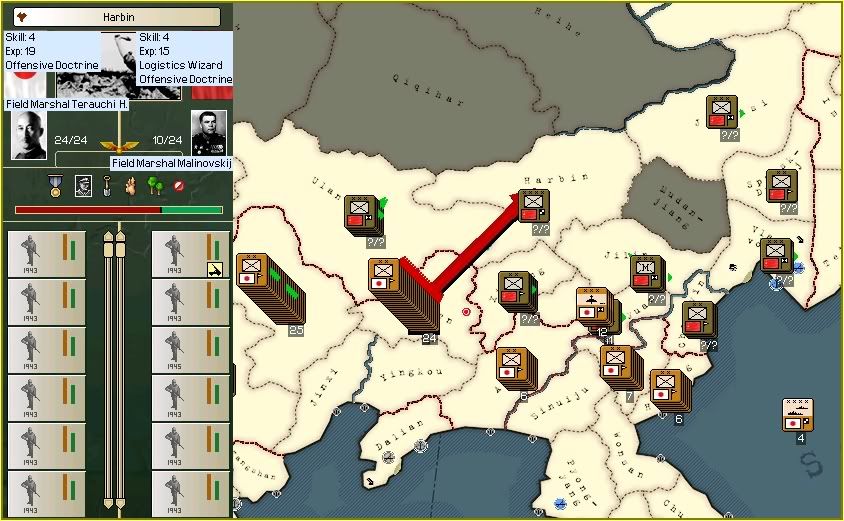
By 2300 hours the ten divisions defending Harbin, commanded by the capable Field Marshall Malinovskij, were fighting for survival as twenty four enemy divisions attacked them without any warning. Terauchi would lead the attack himself as his over supplied forces applied pressure to the under supplied Soviets facing them.
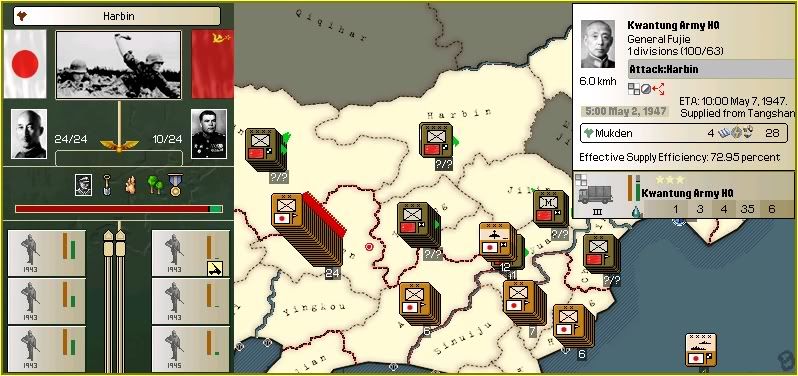
The situation deteriorated rapidly for Malinovskij as his defences crumbled. By 0400 hours the situation had become untenable as his troops began to suffer an increasing number of casualties which would force him to retreat at 0500 hours.
Twenty three Japanese divisions followed their orders and stopped their advance. Only General Fujie and the Kwantung Army Headquarters division continued to advance into the now defenceless Harbin. Terauchi had no idea how many enemy divisions were north of Harbin and he was not going to commit his only strike army to a possible reversal early in the campaign. His orders were to destroy the Soviet Army Group, they did not say he had to do it in one move, and he would take whatever precautions he could to save Japanese lives.
Twenty three Japanese divisions followed their orders and stopped their advance. Only General Fujie and the Kwantung Army Headquarters division continued to advance into the now defenceless Harbin. Terauchi had no idea how many enemy divisions were north of Harbin and he was not going to commit his only strike army to a possible reversal early in the campaign. His orders were to destroy the Soviet Army Group, they did not say he had to do it in one move, and he would take whatever precautions he could to save Japanese lives.
Like all plans made during War they rarely survive long. This one would be no exception. Three hours after the victory in Harbin Terauchi received word of the Soviet response.

Field Marshall Kuznetsov had taken the opportunity to launch a major assault on General Tanaka Shizuichi's position in Andong. This threatened to cut the Kwantung Army in half as it had done during previous attempts. Kuznetsov would be aware that his forces in Xinjing were immune from the normal counter attack from Mukden as Terauchi needed time to reorganise from his own attack.
Andong's defenders would be on their own until 0500 hours the next day. Their situation was not hopeless despite being heavily outnumbered. Both forces were fairly equal on experience but the Japanese troops had several advantages. They had a more capable commander and their entire force had extra supplies which only some of the Soviet divisions could muster. Above all they were defending a mountain and night was only three hours away. All Tanaka Shikuichi needed to do was survive until sunset with minor losses and he should be able to hold until Terauchi could come to his aid.
Andong's defenders would be on their own until 0500 hours the next day. Their situation was not hopeless despite being heavily outnumbered. Both forces were fairly equal on experience but the Japanese troops had several advantages. They had a more capable commander and their entire force had extra supplies which only some of the Soviet divisions could muster. Above all they were defending a mountain and night was only three hours away. All Tanaka Shikuichi needed to do was survive until sunset with minor losses and he should be able to hold until Terauchi could come to his aid.
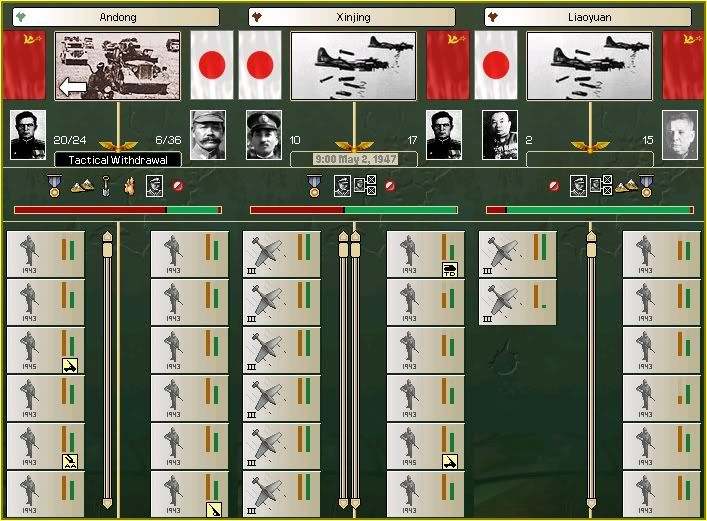
The easiest way to survive with minimal casualties is to make a slow withdraw. Tanaka Shizuichi outmanouvered Kuznetsov an hour after the battle began as he began a Tactical Withdrawal through the mountains of Andong. Only one side would be suffering during the twilight and night that would follow. Terauchi would also receive all the intelligence he required as Japanese Dive bombers attacked both Liaoyuan and Xinjing provinces.
Eleven of the Soviet divisions attacking Andong were from Liaoyuan and only nine from Xinjing. Most of the remaining forces in Xinjing were already retreating from previous attacks on the province. The Red Army soldiers had exhausted most of their meager supplies already.
Eleven of the Soviet divisions attacking Andong were from Liaoyuan and only nine from Xinjing. Most of the remaining forces in Xinjing were already retreating from previous attacks on the province. The Red Army soldiers had exhausted most of their meager supplies already.
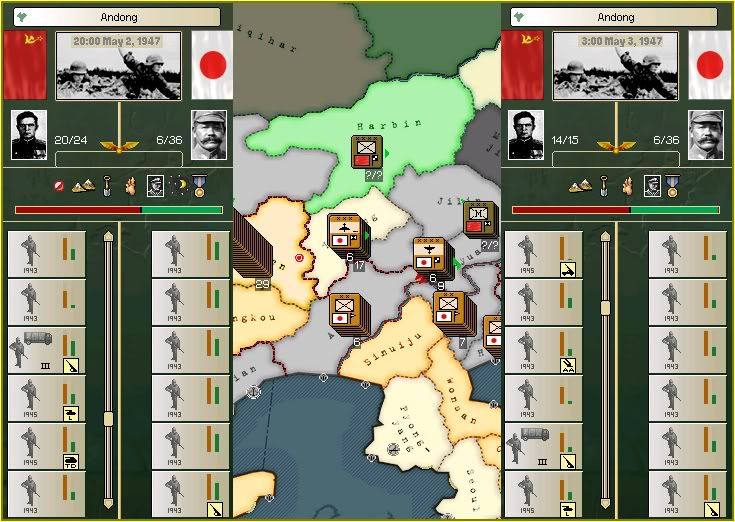
By 2000 hours on May 2nd only two things had really altered. Tanaka Shizuichi no longer possessed a tactical advantage and Kuznetsov was losing troops very quickly. Daylight would allow the Soviet troops more chance to use their numbers and Japanese troops began to suffer more casualties as a result.
By 0300 hours on May 3rd six Soviet divisions had been forced to abandon the assault as Japanese Dive bombers began to inflict heavy casualties on their chosen targets in both provinces. Kuznetsov had no options left as Terauchi began to give the orders that would break his attack once and for all. At 0400 hours the Red Army halted its attack on Andong after suffering a large number of losses for almost no gain.
By 0300 hours on May 3rd six Soviet divisions had been forced to abandon the assault as Japanese Dive bombers began to inflict heavy casualties on their chosen targets in both provinces. Kuznetsov had no options left as Terauchi began to give the orders that would break his attack once and for all. At 0400 hours the Red Army halted its attack on Andong after suffering a large number of losses for almost no gain.
0000 May 3rd 1947.
North China Army Headquarters. Lanzhou, China.
Higashikuni had been watching progress in the north but he had his own area to defend. The possibility still existed that Zhukov would ignore anything that was happening elsewhere along the line and continue to advance into Higashikuni's weaker left flank.
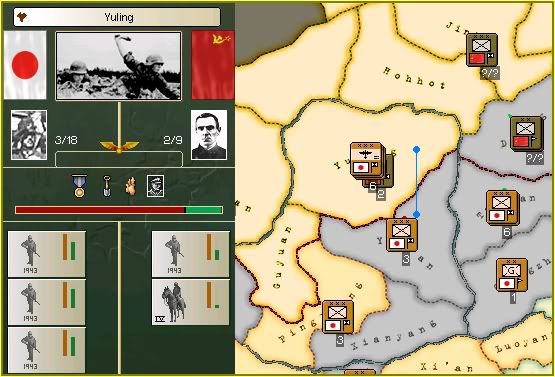
The right flank and center were a lot more stable than they had been which allowed for some minor counter attacks on occasion. General Sakai led the attack against the weakened defenders of Yuling. Japanese Tactical bombers had spent most of the previous day softening up the defenders which made the attack a quick one as the Soviets retreated after two hours. The bombers would find it a lot easier to kill fleeing troops than ones that were heavily entrenched.

In Iraq the Cavalry division defending Baghdad had come under attack from a Cuban Tactical bomber squadron. The now veteran Mj. General Kato led his fully upgraded Interceptor wing in to the air. The outdated Cuban aircraft lasted slightly longer than their Panamanian collegues had but the end result would be the same.
0600 May 3rd 1947.
Kwantung Army Headquarters. Mukden, Manchukuo.
The collapse of the attack on Andong could have allowed Terauchi to rescind his orders to assault Xinjing. Unfortunately for Kuznetsov those orders would have been given regardless of his own actions. All he had done was to ensure his defeat would be a lot quicker.
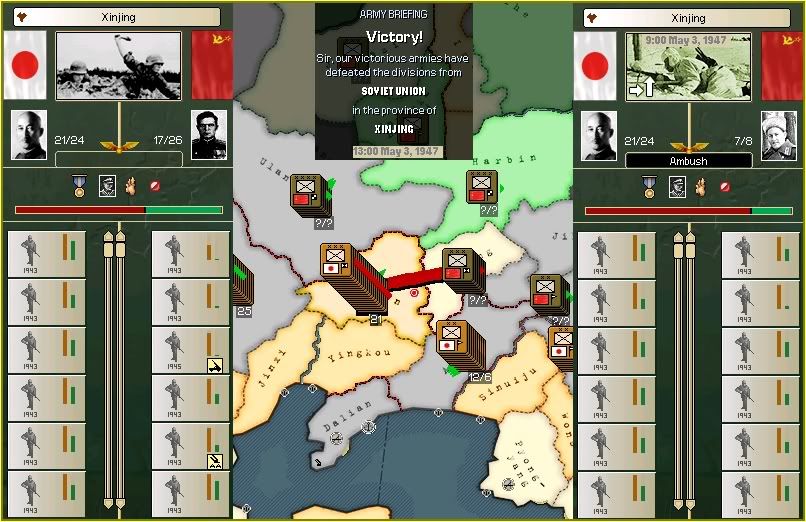
By 0600 hours twenty one Japanese divisions, again led by Terauchi, attacked the severely weakened Soviet forces in Xinjing. By 0900 ten divisions had adandoned the defences leaving only seven to fight on. Their position deteriorated further when Terauchi managed to ambush part of their forces. Night would bring no respite for the Soviets as Japanese troops relished fighting during this period of the day and by 1300 hours it was over.
This time Terauchi would advance and bring twenty one divisions with him to liberate the capital of Manchukuo.
This time Terauchi would advance and bring twenty one divisions with him to liberate the capital of Manchukuo.
Last edited:
It begins indeed  . The reclaiming of Manchuria now is inevitable.
. The reclaiming of Manchuria now is inevitable.
I do wonder how tthe Soviet AI with it's massive IC manages to get a supply shortage
Gameplay question: When you start invading Russia itself from Manchuria, will that mean all territory comes under the control of Manchuria or, because it's a puppet, will it become yours?
I do wonder how tthe Soviet AI with it's massive IC manages to get a supply shortage
Gameplay question: When you start invading Russia itself from Manchuria, will that mean all territory comes under the control of Manchuria or, because it's a puppet, will it become yours?
Very interesting move and one that really could make a change. You're going to do a amphibious assault north of Vladivostok, aren't you? Those divisions in Asahikawa aren't there on vacation, I think... It would become a double encirclement which is a lot faster in that terrain than just driving your main forces eastwards to the sea. Even if you take one province on the coast, you'll save days. The earlier the pocket closes, the faster the enemy loses supply and org and is easier to defeat with minimal Japanese casualties. Good job this far, let's see how succesful that move will be.
Last edited:
I think that Manchurian territory goes to Manchuria and the rest to Japan...I may be wrong. 
ColossusCrusher said:I think that Manchurian territory goes to Manchuria and the rest to Japan...I may be wrong.
You are right, sir.
I have couple of questions:
How may HQ do you have, and how many are used right now?
And what are your ultimate MP reserves in troops which could be disbanded? (wider Asian fron will require more HQs)
How may HQ do you have, and how many are used right now?
And what are your ultimate MP reserves in troops which could be disbanded? (wider Asian fron will require more HQs)
if i were you, i sent CAS just for interdiction. if they manage to break the encirclement which you don`t let it happen i believe, you loose a lot of time. the retreating divisions will be yours in anyway, the divisions in Jilin, Guyuan, Ulan Hot and Vladivostok are supposed to be softened before you move those areas.
and there is a big force in Ulan Hot (some of them are moving to Xinjing), are you gonna make a visit to them? they are out of supplies, you can bring them some tea
Poor Cuban pilots, they died for nothing and the public is peaceless and arguing the government decisions. an uprising is close there against Batista ...
and i think you make your amphibious assault to Iman province. you can link to Harbin easier from there...
and one question, what is the dead line for this game? December, 48?
good luck
and there is a big force in Ulan Hot (some of them are moving to Xinjing), are you gonna make a visit to them? they are out of supplies, you can bring them some tea
Poor Cuban pilots, they died for nothing and the public is peaceless and arguing the government decisions. an uprising is close there against Batista ...
and i think you make your amphibious assault to Iman province. you can link to Harbin easier from there...
and one question, what is the dead line for this game? December, 48?
good luck
I noticed the Ruskies still have a 5% decryption modifier against you. How long is going to be till you have this eliminated. I know it doesn't sound like much but a 5% casualty reduction over a year is a significant amount of manpower.
It seems I was right about Operation Improbables objective.
Good luck, it seems you have gotten of to an alright start though.
Good luck, it seems you have gotten of to an alright start though.
It depends on who's supplying the troops. If they're Japanese-supplied, all non-Manchurian national territory will go to Japan. If they're supplied by the Manchurians, then they'll get any new gains.ColossusCrusher said:I think that Manchurian territory goes to Manchuria and the rest to Japan...I may be wrong.
Remble, you might have mentioned this before, but I don't remember. Whose troops are the ones receiving the "out of supply" modifier in these battles?
AdmiralNelson said:Remble, you might have mentioned this before, but I don't remember. Whose troops are the ones receiving the "out of supply" modifier in these battles?
That would be the Soviet army. AI never produces much supplies, and a large army with lots of offensive supply drains the basket emply rather often. However, I think that them being out of supply is just occasional, thus having no effect on their org levels. Of course, in a major battle that modifier really can make a difference.
Velko said:That would be the Soviet army. AI never produces much supplies, and a large army with lots of offensive supply drains the basket emply rather often. However, I think that them being out of supply is just occasional, thus having no effect on their org levels. Of course, in a major battle that modifier really can make a difference.
That's what I thought. I just find it odd that the Soviets can't find the IC to produce enough supplies. Oh well, weird AI, I guess.
Inner Circle - But who will be getting slaughtered 
FlorisDeVijfde, ColossusCrusher, Chief Savage Ma, thatguy - Unfortunately the Soviet AI is always suffering supply shortages even though it should never happen. I am trying to do all I can to assist it but its troops are not dieing fast enough.
Any territory outside of my puppets will become Japanese if it is Japanese troops that take it, no matter where they move from.
Velko - Thanks. That option is one I could choose yes. Terauchi will be picking an alternative and smaller encirclement as I don't like to use big ones against the AI unless I have little to no choice.
zdlugasz - I have 10 HQ's of which 2 are in Japan and could be disbanded. After that I will probably start to disband the less useful brigades if I need to.
harezmi - Thank you. Using the CAS that way would be nice but I can't unfortunately. Guyuan I could do it to but Jilin and Vladivostok are out of CAS range. Ulan Hot is in the same bomb zone as Liaoyuan and the CAS prefer to bomb that province.
The enemy troops from Ulan Hot are moving towards Harbin right now so are no direct threat. I may or may not attack them at some point.
Baghdad seems to be popular for the smaller enemy Air Forces
Deadline is December 30th 1953.
Kanitatlan - They managed to switch to an advantage from a disadvantage fairly quickly. I am 85% into the next Decryption Tech which will only leave 2 in that research path. By the end of the month it should be equal.
Maj. von Mauser - You were correct indeed. Thank you
AdmiralNelson, Velko - Velko is correct it is the enemy with supply problems.
Update to follow ...
FlorisDeVijfde, ColossusCrusher, Chief Savage Ma, thatguy - Unfortunately the Soviet AI is always suffering supply shortages even though it should never happen. I am trying to do all I can to assist it but its troops are not dieing fast enough.
Any territory outside of my puppets will become Japanese if it is Japanese troops that take it, no matter where they move from.
Velko - Thanks. That option is one I could choose yes. Terauchi will be picking an alternative and smaller encirclement as I don't like to use big ones against the AI unless I have little to no choice.
zdlugasz - I have 10 HQ's of which 2 are in Japan and could be disbanded. After that I will probably start to disband the less useful brigades if I need to.
harezmi - Thank you. Using the CAS that way would be nice but I can't unfortunately. Guyuan I could do it to but Jilin and Vladivostok are out of CAS range. Ulan Hot is in the same bomb zone as Liaoyuan and the CAS prefer to bomb that province.
The enemy troops from Ulan Hot are moving towards Harbin right now so are no direct threat. I may or may not attack them at some point.
Baghdad seems to be popular for the smaller enemy Air Forces
Deadline is December 30th 1953.
Kanitatlan - They managed to switch to an advantage from a disadvantage fairly quickly. I am 85% into the next Decryption Tech which will only leave 2 in that research path. By the end of the month it should be equal.
Maj. von Mauser - You were correct indeed. Thank you
AdmiralNelson, Velko - Velko is correct it is the enemy with supply problems.
Update to follow ...
Inner Circle said:now the big manslaughter begins...
Japanese soldiers slaughtering Soviet soldiers...just a regular day at the office. This time, however, the Japanese are actually advancing. Good luck, Remble.
Operation Improbable
2
2
0900 May 3rd 1947.
North China Army Headquarters. Lanzhou, China.
Higashikuni was keeping a close eye on Soviet movements along his part of the front as the Kwantung Army began its attacks in the north. No sign had so far been observed of Zhukov reacting to events. Attention would be drawn towards India in the mean time.
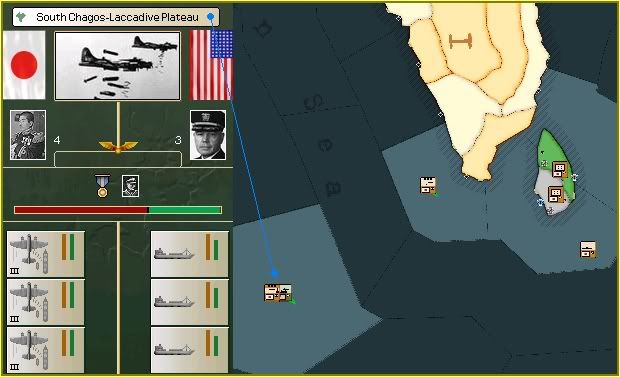
Ichimaru and Genda had begun to patrol the sealanes close to Ceylon to try and sight any incoming enemy vessels. They found and attacked three American Transport Flotillas in the early morning of May 3rd and would sink one of them. They appeared to be heading towards Colombo where BB Division 1 was still in attendance.
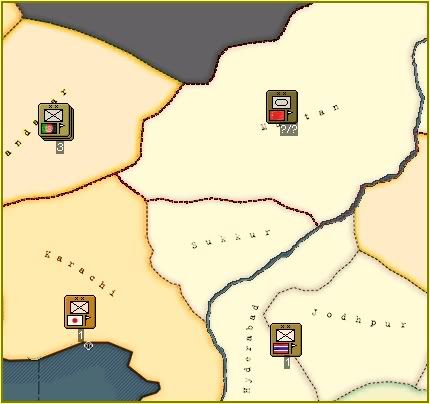
The remaining Soviet Armoured division in northern India had advanced into Multan province but its time would be short as it had already been badly damaged by the prowling Tactical bombers operating from Ahmadabad.
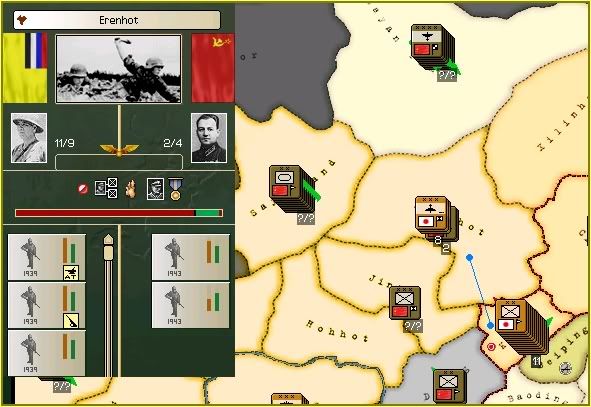
There were signs of continued build up of Red Army forces in and around the gap between the two Japanese Armies as troops launched their latest assault on Erenhot to prevent any serious concentration of enemy troops. The Soviets were still suffering intermitant supply problems as they were forced to retreat under air attack by Japanese Dive bombers from Beiping.
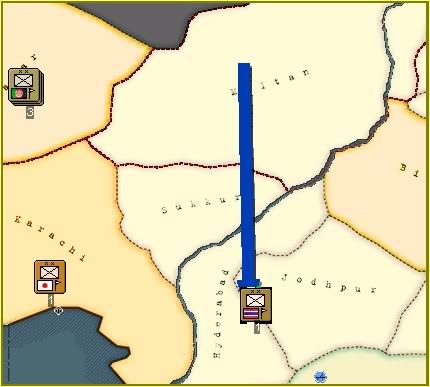
The destruction of the Armour in Multan would allow the recapture of the province by a Siamese division which was guarding Hyderabad. The Tactical bombers would be allowed some time to rest as they awaited the Soviet Infantrys arrival in northern India.
0000 May 4th 1947.
Security Offices. Tokyo, Japan.
Minister Hakujiro had one of the easier tasks in the Japanese Cabinet as he merely had to monitor and contain any partisan activity in Japanese territory. Uprisings were rare and there were usually forces on hand to deal with such events.
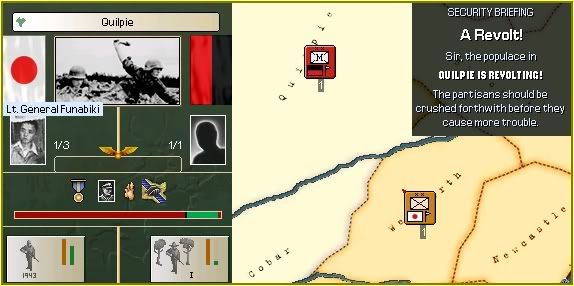
The revolt in Quilpie in Australia was quickly and easily put down by Lt. General Funabiki who was carrying out anti-partisan patrols around Wentworth. It appeared that the current Japanese forces in the country would be required to stay for some time to come in case of further outbreaks.
0400 May 4th 1947.
Kwantung Army Headquarters. Mukden, Manchukuo.
There had been some limited response around Manchuria as Japanese forces attacked both Harbin and Xinjing provinces. Enemy movements were mostly towards Harbin with some moving towards the coast from Liaoyuan.
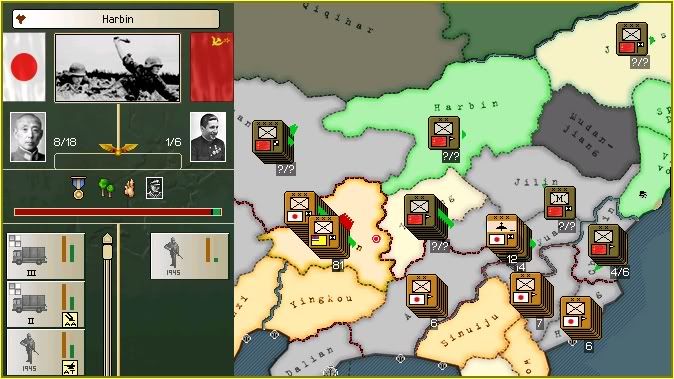
General Fujie would encounter some minor resistance to his advance towards Harbin but the support of local Manchurian divisions would allow him to continue on towards the province.

At 1700 hours on May 5th combined forces arrived in the capital of Manchukuo. Xinjing would be returned to Manchurian forces as Terauchi thought on his next move. He had several options.
He could move north to Harbin in force to try and secure that province but this would be ruled out as it was not known what size of enemy force was close by.
The second option would be to attack towards Jilin and await an opportunity to seize Vladivostok again in an attempt to isolate enemy troops in Chongyin and Liaoyuan and then destroy them.
His final consideration would be an attack towards Liaoyuan from Andong with support from forces either side of the province. This would merely push Soviet forces northwards where they would still maintain a mountain defence and would be fully operational in a short time.
He could move north to Harbin in force to try and secure that province but this would be ruled out as it was not known what size of enemy force was close by.
The second option would be to attack towards Jilin and await an opportunity to seize Vladivostok again in an attempt to isolate enemy troops in Chongyin and Liaoyuan and then destroy them.
His final consideration would be an attack towards Liaoyuan from Andong with support from forces either side of the province. This would merely push Soviet forces northwards where they would still maintain a mountain defence and would be fully operational in a short time.
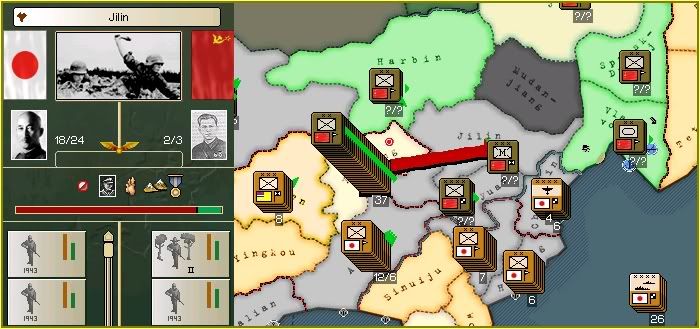
Terauchi would choose the second option and try to cut off part of the enemy Army Group. The attack on Jilin would be routine but he was moving outside of his air cover in doing so. A more important consideration was the three week marching time with a large Soviet force retreating from Xinjing to either Jilin or Liaoyuan. There was also the ten divisions of enemy troops retreating from Harbin to Mudanjiang to consider. He had made his choice and would pursue the chosen course until he was forced to consider other options.

